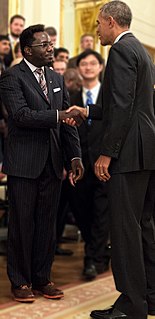Related Research Articles

Photonics is the physical science and application of light (photon) generation, detection, and manipulation through emission, transmission, modulation, signal processing, switching, amplification, and sensing. Though covering all light's technical applications over the whole spectrum, most photonic applications are in the range of visible and near-infrared light. The term photonics developed as an outgrowth of the first practical semiconductor light emitters invented in the early 1960s and optical fibers developed in the 1970s.

Cochin University of Science and Technology (CUSAT) is a government-owned autonomous science and technology university in Kochi, Kerala, India. It was founded in 1971 and has two campuses: one in Kochi, and one in Kuttanad, Alappuzha, 66 km (41 mi) inland. The university awards degrees in engineering and science at the undergraduate, postgraduate and doctoral levels. In the 2016-17 Times Higher Education World University Rankings, CUSAT is the only institution in Kerala, is one among the 31 institutions in the country to be ranked in the global survey.
The following outline is provided as an overview of and topical guide to electrical engineering.

Applied physics is the application of physics to solve scientific or engineering problems. It is usually considered to be a bridge or a connection between physics and engineering.
The School of Engineering and Applied Science (SEAS) at the George Washington University in Washington, D.C. is a technical school which specializes in engineering, technology, communications, and transportation. The school is located on the main campus of the George Washington University and offers both undergraduate and graduate programs.

The Edward E. Whitacre Jr. College of Engineering is the college of engineering at Texas Tech University in Lubbock, Texas. The engineering program has existed at Texas Tech University since 1925. Additionally, the Whitacre College of Engineering administers graduate engineering degree programs at the university's campus in Amarillo, Texas. Many of the college's degree programs are accredited by ABET. The Whitacre College of Engineering is the first and, presently, only school in the world to offer a doctor of philosophy degree in wind science and engineering.
The Advanced Learning and Research Institute (ALaRI), a faculty of informatics, was established in 1999 at the University of Lugano with the mission of promoting research and education in embedded systems. The Faculty of Informatics within very few years has become one of the Switzerland major destinations for teaching and research, ranking third after the two Federal Institutes of Technology, Zurich and Lausanne.
In 1995, professor Massimo Grattarola of the Biophysics and Electrical Engineering Department (DIBE) at the University of Genoa, in Genoa, Italy, created an undergraduate and graduate program named neurobioengineering. The program was designed to amalgamate anthropomorphic robotics, artificial intelligence, bioelectronics, electrical engineering, molecular biology, physics, and medicine, into a single program with the aim of developing advanced bio-compatible neuro-prosthetic implants for a variety applications.
Bioelectronics is a field of research in the convergence of biology and electronics.

The Volgenau School of Engineering is located in the Fairfax campus of George Mason University in the Commonwealth of Virginia. The Volgenau School offers programs at the B.S., M.S., and Ph.D. levels.
The College of Engineering Vadakara (CEV) is an engineering college in Kozhikode district of Kerala, established in 1999.
The Microsystems Technology Office (MTO) is one of seven current organizational divisions of DARPA, an agency responsible for the development of new technology for the United States Armed Forces. It is sometimes referred to as the Microelectronics Technology Office.
The Rice Center for Neuroengineering is an interdisciplinary research center, founded in 2014, housed within Rice University's Department of Electrical and Computer Engineering. The center is funded by an NSF IGERT grant, DARPA, the W.M. Keck Foundation, and Texas Instruments. Partner Institutions include Rice University, Baylor College of Medicine, the University of Texas Health Science Center, and the Gulf Coast Consortia. Facilities are located on the Rice University campus and in the Texas Medical Center.

The Fraunhofer Institute for Telecommunications, Heinrich Hertz Institute, HHI, also known as Fraunhofer HHI or Fraunhofer Heinrich Hertz Institute, is an organization of the Fraunhofer Society based in Berlin. The institute engages in applied research and development in the fields of physics, electrical engineering and computer sciences.

Deji Akinwande is a Professor of Electrical and Computer Engineering with courtesy affiliation with Materials Science at the University of Texas at Austin. He was awarded the Presidential Early Career Award for Scientists and Engineers in 2016 from Barack Obama. He is a Fellow of the American Physical Society, and the IEEE. He is a Nigerian-American.
Brian T. Cunningham is an American engineer, researcher and academic. He is a Donald Biggar Willett Professor of Engineering at University of Illinois at Urbana-Champaign. He is a professor of Electrical and Computer Engineering, and a professor of Bioengineering.

The TUM Department of Electrical and Computer Engineering is a department of the Technical University of Munich, located at its Munich campus.
References
- ↑ "Department History" . Retrieved 12 July 2015.
- ↑ "ECE Research" . Retrieved 12 July 2015.
- ↑ "Tittel Receives Award from Welch Foundation" . Retrieved 12 July 2015.